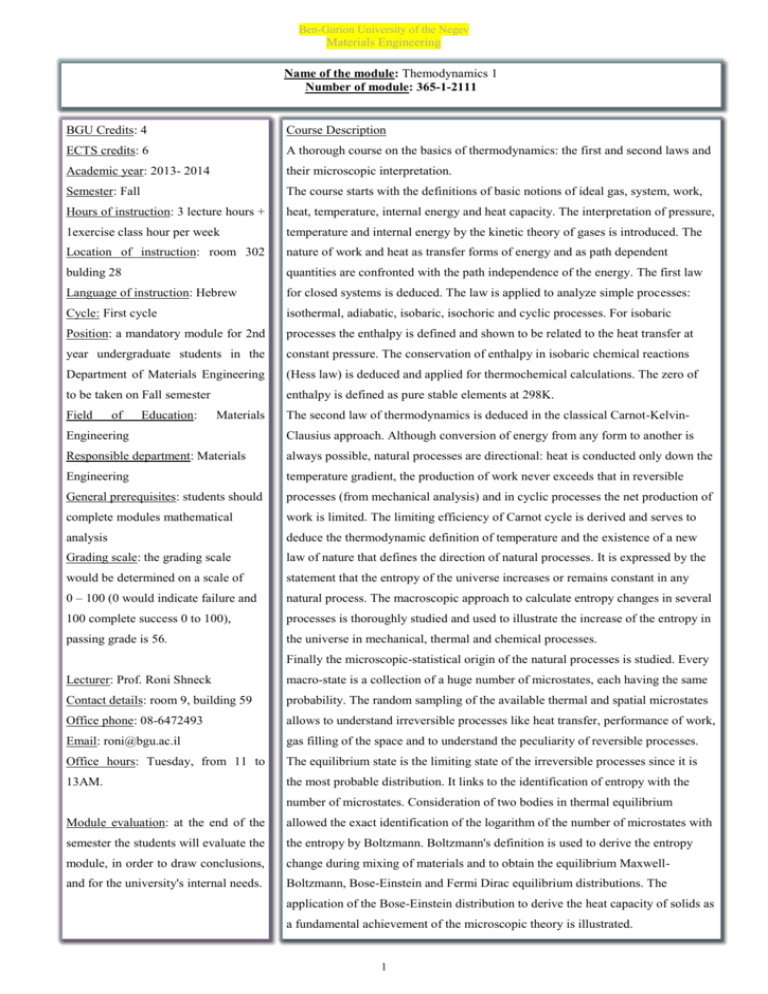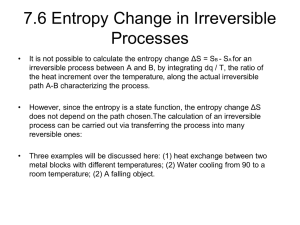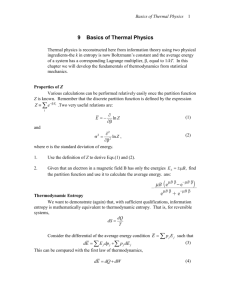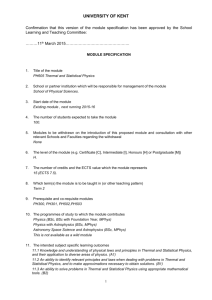Ben-Gurion University of the Negev Materials Engineering Name of
advertisement

Ben-Gurion University of the Negev Materials Engineering Name of the module: Themodynamics 1 Number of module: 365-1-2111 BGU Credits: 4 Course Description ECTS credits: 6 A thorough course on the basics of thermodynamics: the first and second laws and Academic year: 2013- 2014 their microscopic interpretation. Semester: Fall The course starts with the definitions of basic notions of ideal gas, system, work, Hours of instruction: 3 lecture hours + heat, temperature, internal energy and heat capacity. The interpretation of pressure, 1exercise class hour per week temperature and internal energy by the kinetic theory of gases is introduced. The Location of instruction: room 302 nature of work and heat as transfer forms of energy and as path dependent bulding 28 quantities are confronted with the path independence of the energy. The first law Language of instruction: Hebrew for closed systems is deduced. The law is applied to analyze simple processes: Cycle: First cycle isothermal, adiabatic, isobaric, isochoric and cyclic processes. For isobaric Position: a mandatory module for 2nd processes the enthalpy is defined and shown to be related to the heat transfer at year undergraduate students in the constant pressure. The conservation of enthalpy in isobaric chemical reactions Department of Materials Engineering (Hess law) is deduced and applied for thermochemical calculations. The zero of to be taken on Fall semester enthalpy is defined as pure stable elements at 298K. Field of Education: Materials The second law of thermodynamics is deduced in the classical Carnot-Kelvin- Engineering Clausius approach. Although conversion of energy from any form to another is Responsible department: Materials always possible, natural processes are directional: heat is conducted only down the Engineering temperature gradient, the production of work never exceeds that in reversible General prerequisites: students should processes (from mechanical analysis) and in cyclic processes the net production of complete modules mathematical work is limited. The limiting efficiency of Carnot cycle is derived and serves to analysis deduce the thermodynamic definition of temperature and the existence of a new Grading scale: the grading scale law of nature that defines the direction of natural processes. It is expressed by the would be determined on a scale of statement that the entropy of the universe increases or remains constant in any 0 – 100 (0 would indicate failure and natural process. The macroscopic approach to calculate entropy changes in several 100 complete success 0 to 100), processes is thoroughly studied and used to illustrate the increase of the entropy in passing grade is 56. the universe in mechanical, thermal and chemical processes. Finally the microscopic-statistical origin of the natural processes is studied. Every Lecturer: Prof. Roni Shneck macro-state is a collection of a huge number of microstates, each having the same Contact details: room 9, building 59 probability. The random sampling of the available thermal and spatial microstates Office phone: 08-6472493 allows to understand irreversible processes like heat transfer, performance of work, Email: roni@bgu.ac.il gas filling of the space and to understand the peculiarity of reversible processes. Office hours: Tuesday, from 11 to The equilibrium state is the limiting state of the irreversible processes since it is 13AM. the most probable distribution. It links to the identification of entropy with the number of microstates. Consideration of two bodies in thermal equilibrium Module evaluation: at the end of the allowed the exact identification of the logarithm of the number of microstates with semester the students will evaluate the the entropy by Boltzmann. Boltzmann's definition is used to derive the entropy module, in order to draw conclusions, change during mixing of materials and to obtain the equilibrium Maxwell- and for the university's internal needs. Boltzmann, Bose-Einstein and Fermi Dirac equilibrium distributions. The application of the Bose-Einstein distribution to derive the heat capacity of solids as a fundamental achievement of the microscopic theory is illustrated. 1 Ben-Gurion University of the Negev Materials Engineering Confirmation: the syllabus was Objectives confirmed by the faculty academic advisory committee to be valid on 2013-2014. Last update: 1. Gain knowledge about the notions of thermodynamics: work, heat, temperature, heat capacity, internal energy and enthalpy. 2. Gain a thorough understanding of the first and second laws of thermodynamics and the microscopic-statistical interpretation of the entropy and the second law. 3. Knowledge to analyze mechanical, thermal and thermochemical processes and cycles and determine their efficiency. 4. Knowledge to estimate the degree of irreversibility in natural processes. Aims Develop a foundation of understanding of the basic notions and laws of thermodynamics and their microscopic interpretation. Develop knowledge to apply thermodynamics for general engineering processes. Learning outcomes of the module: On successful completion of the course the students should 1. Understand the generalized law of conservation of energy. Understanding the path dependence of heat and work and independence of path of state functions. Be familiar with the definitions of internal energy, enthalpy, heat capacity(at constant volume and in constant pressure), system and its interactions. Able to apply the first law to closed systems, simple processes and cycles. 2. Able to calculate enthalpy changes of materials with temperature, in particular during phase changes. Calculate heat of chemical reactions (Hess law) and its applications. 3. Analyze simple heat engines and refrigerators, calculation of heat and work balances and thermodynamic efficiency. Calculate entropy changes in reversible and in natural processes along equivalent reversible paths. Show that the entropy of the universe increases in natural processes. Determine the direction of natural processes by calculation of the entropy. 4. Understand the microscopic interpretation of the entropy and the second law. Definition of macrostates, microstates, distributions, most probable distribution, equilibrium distributions. Provide simple illustrations of the increase of the number of microstates in natural processes. Explain the microscopic difference between reversible and irreversible processes. Attendance regulation: attendance and participation in class is recommended. Teaching arrangement and method of instruction: The module consists of lectures and exercises. Assessment: 1. Exam 65% (or 85% for the student who has lower grade in the quiz) 2. Quiz 20% (not mandatory) 3. Homeworks 15% 100% 2 Ben-Gurion University of the Negev Materials Engineering Module Content / schedule and outlines (a) The first law Discussion and definition of force, work, temperature and heat their relations and properties 3h Introduction of the internal energy and the first law of thermodynamics 3h Calculation of external work and heat 2h Calculation of changes in the internal energy, the heat capacity at constant volume of different materials 2h Simple processes: adiabatic, isothermal, refrigerating cycle, isochoric and isobaric processes 3h Enthalpy and thermochemistry 4h (b) The second law Introduction to the second law: definition of reversible process, the limiting properties of reversible processes 3h Carnot cycle of ideal gas, limited efficiency of a heat engine 1h The Clausius, the Kelvin and the Carnot statements of the second law and their equivalence 3h Definition of the thermodynamic temperature, Clausius inequality, entropy and the quantitative statement of the second law 4h Applications of the second law, calculation of entropy in reversible and irreversible processes 3h (c) Microscopic interpretation Introduction to statistical thermodynamics: macrostates, microstates, most probable distribution 2h The microscopic interpretation of natural processes: heat transfer and the Boltzmann definition of entropy and temperature, entropy of mixing 3h Thermal and configurational entropy, discussion of the microscopic interpretation of reversible and irreversible processes 2h Equilibrium distributions and heat capacity of solids 1h Exercises: The ideal gas, state functions Calculation of heat, work and internal energy change in real and ideal gases Application of the first law to analyze processes and cycles Enthalpy and thermochemistry Introduction to the second law- reversible and irreversible processes Analysis of heat engines and refrigerators Calculations of entropy changes in reversible and irreversible processes: thermal, mechanical and chemical irreversibilities Simple calculations of number of microstates Applications of Boltzmann definition of entropy Examples of the microscopic interpretation of reversible and irreversible processes 3 Ben-Gurion University of the Negev Materials Engineering Required reading: 1. E. Fermi, Thermodynamics, New York : Dover Publications, [1956, C1937) (QC 311.F47 1956) 2. .Dilip Kondepudi and Ilya Prigogine, Modern thermodynamics , Chichester, England : Wiley, 2005. (QC 311.K66 2005) or 3. M.W. Zemansky and R.H. Dittman, Heat and thermodynamics, New York : McGraw-Hill, 1997 (QC 254.Z45 1997) 3. Lecture notes (in Hebrew): (a) First law of thermodynamics. (b) Second law of thermodynamics (c) Statistical interpretation of the second law Additional literature: 1 Merle C. Potter, Craig W. Somerto Schaum’s outline of thermodynamics for engineers, New York : McGraw-Hill, 2006.( TJ 265.P682 2006) 2. H. B. Callen, Thermodynamics and an introduction to Thermostatics , New York : Wiley, c1985 (QC 311.C25 1985) . 4








